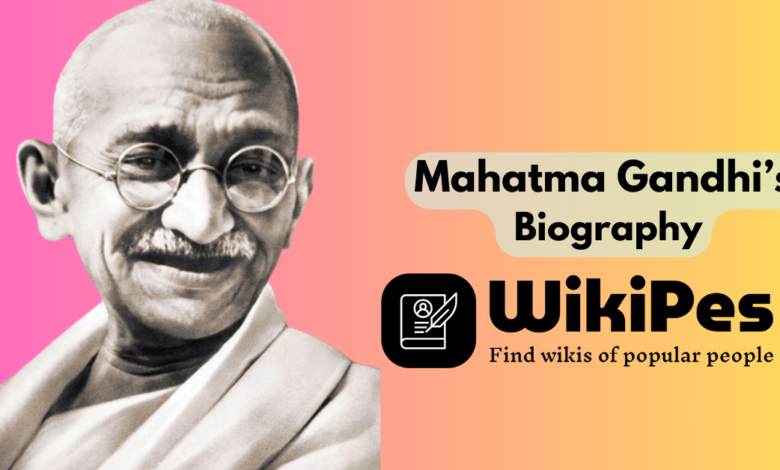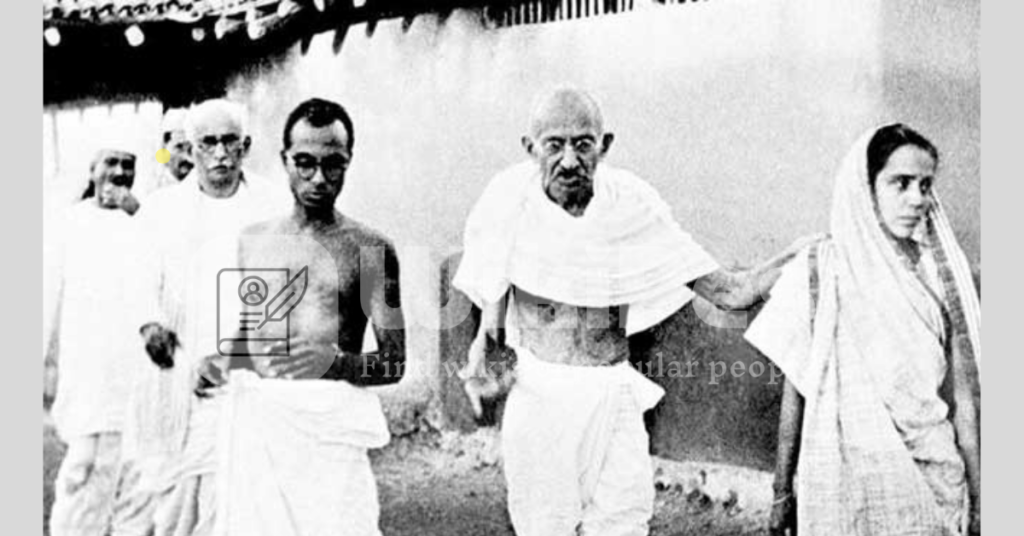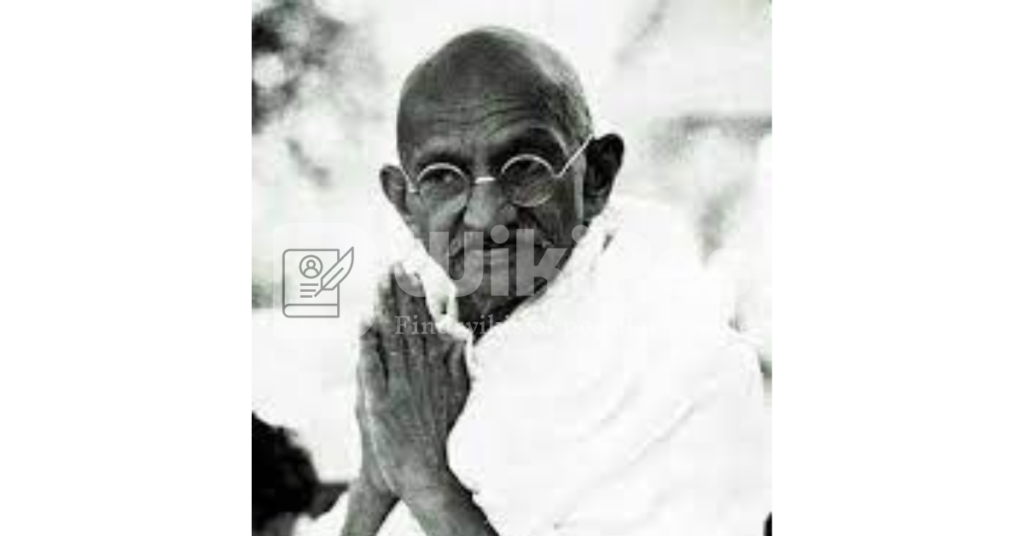Mahatma Gandhi: The Story Behind The Height, Weight, Age, Career, And Success

In the realm of history, there are a few individuals who shine brighter than the rest. One such luminary is Mahatma Gandhi. You may have heard his name before, and today, we’re going to delve into the life and achievements of this remarkable figure.
Mahatma Gandhi, also known as the Father of the Nation in India, was a symbol of peace, non-violence, and freedom. Born on October 2, 1869, in Porbandar, a coastal town in Gujarat, India, Gandhi left an indelible mark on the world.
Gandhi’s journey was one of resilience and determination, as he led India to independence from British rule through his extraordinary acts of civil disobedience and non-violent protests. Join us as we uncover the mesmerizing story of Mahatma Gandhi, an inspiration to millions around the globe.
Mahatma Gandhi was a prominent leader of India’s independence movement. He was of average height, standing at around 5ft 4 in, and weighed approximately 103 lbs. While Gandhi’s wealth was modest, his net worth was estimated to be around $88,000 at the time of his death in 1948. He lived a simple and frugal lifestyle, focusing on his principles of non-violence and compassion. Gandhi’s dedication to social justice, civil rights, and peace earned him worldwide recognition and he is considered one of history’s most influential personalities.
Biography Mahatma Gandhi – Age, Height, Education, Net Worth
| Information | Details |
|---|---|
| Profession | Lawyer |
| Weight | 103 lbs |
| Religion | Hinduism |
| Ethnicity | Indian |
| Birthplace/Hometown | Porbandar, Gujarat, India |
| Date of Birth | October 2, 1869 |
| Eye Color | Brown |
| Name | Mahatma Gandhi |
| Age | 78 |
| House Location | Sabarmati Ashram, Ahmedabad, Gujarat, India |
| Sun Sign (Zodiac Birth Sign) | Libra |
| Nickname | Bapu |
| Gender | Male |
| Nationality | Indian |
| Sexuality | Straight |
| Net Worth | Unknown |
| Hair Color | Black |
| Body Measurement | N/A |
| Wiki Page | https://en.wikipedia.org/wiki/Mahatma_Gandhi |
| Facebook Link | Unknown |
| Twitter Profile Link | Unknown |
Physical Statistics
| Information | Details |
|---|---|
| Eye Color | Brown |
| Weight | 103 lbs |
| Height (Tall) | 5ft 4 in |
| Shoe Size (UK) | 8 |
| Profession | Lawyer, Politician, Activist |
| Hair Color | Black |
Family
| Information | Details |
|---|---|
| Father | Karamchand Gandhi |
| Mother | Putlibai Gandhi |
| Husband/Spouse | Kasturba Gandhi |
| Siblings | Laxmidas Gandhi Kasbekar Gandhi Raliatbehn Gandhi Karsandas Gandhi |
Mahatma Gandhi: A Life of Purpose and Influence
Mahatma Gandhi, also known as Mohandas Karamchand Gandhi, was a prominent leader, activist, and writer who played a vital role in India’s fight for independence from British rule. His philosophies of non-violence, truth, and self-reliance continue to inspire millions around the world. In this article, we delve into the personal details, professional achievements, and lasting legacy of Mahatma Gandhi.
The Early Life of Mahatma Gandhi

Mahatma Gandhi was born on October 2, 1869, in Porbandar, a coastal town in British India. From a young age, he displayed a strong sense of justice and a desire to help others. His father, Karamchand Gandhi, served as the diwan (prime minister) of Porbandar, and his mother, Putlibai, deeply influenced his values and character.
A pivotal moment in Gandhi’s life came when he left India at the age of 19 to study law in London. It was during this time that he was exposed to different cultures, ideas, and philosophies, sparking his interest in social reform and advocating for the rights of marginalized communities.
Formative Years in South Africa
After completing his law degree, Gandhi moved to South Africa where he practiced law for 20 years. It was in South Africa that he faced firsthand discrimination and racial prejudice. These experiences ignited his passion for fighting injustice and laid the foundation for his later work in India.
During his time in South Africa, Gandhi faced numerous incidents of racial discrimination and inequality. One such incident occurred when he was forcibly removed from a first-class train compartment, despite holding a valid ticket. This incident inspired Gandhi to fight for the rights of Indians and other marginalized communities living in South Africa.
The Birth of Satyagraha
Gandhi’s journey towards non-violent resistance, or satyagraha, began to take shape during his time in South Africa. The mistreatment he and other Indians faced motivated him to mobilize communities and fight against unfair laws and practices through peaceful means.
Satyagraha advocated for the power of truth and non-violence as a means to achieve justice. Gandhi’s campaigns in South Africa against discriminatory legislation, such as the Asiatic Registration Act, garnered international attention and became a blueprint for his later struggles in India.
Mahatma Gandhi Returns to India

In 1915, Gandhi returned to India and became actively involved in the freedom struggle against British rule. He embraced simplicity, dressing in traditional Indian attire and adopting a minimalist lifestyle. This served as a symbol of his commitment to the Indian way of life and his desire to uplift the marginalized sections of society.
Gandhi’s approach to political activism focused on mobilizing the masses and empowering them to take ownership of their freedom struggle. He believed in swaraj, or self-rule, and urged Indians to reject foreign goods and institutions, advocating for self-sufficiency and the revival of indigenous industries.
Championing Non-Violence
Gandhi’s principle of non-violence, or ahimsa, became the cornerstone of his activism. He believed that violence only perpetuated more violence and sought to find an alternate path to achieving justice. Through non-violent protests and civil disobedience, Gandhi aimed to expose the unfairness of British rule and bring about social and political change.
One of the most significant events in Gandhi’s fight for Indian independence was the Salt March in 1930. In peaceful defiance of British salt laws, Gandhi led thousands on a 240-mile journey to the Arabian Sea to produce their salt. This act of civil disobedience ignited a sense of unity and resistance among the Indian population and furthered the momentum for independence.
The Legacy of Mahatma Gandhi
Mahatma Gandhi’s unwavering commitment to non-violence, truth, and justice left an indelible mark on the world. His influence stretched far beyond the borders of India, inspiring civil rights movements, world leaders, and activists across the globe.
Gandhi’s philosophy of non-violence continues to resonate with people seeking peaceful solutions to conflicts worldwide. He believed that individuals have the power to effect meaningful change through personal transformation and adherence to moral principles.
Despite facing numerous challenges throughout his life, including imprisonment and physical assaults, Gandhi remained steadfast in his pursuit of equality and justice. His dedication and perseverance serve as an example for future generations to stand up against oppression and fight for societal change.
The teachings of Mahatma Gandhi continue to inspire individuals in their personal lives, activism, and pursuit of justice. His emphasis on self-reliance, simplicity, and the power of truth remains relevant in a world marked by inequality and discord. As we remember and honor the legacy of Mahatma Gandhi, let us strive to embody his ideals and work towards creating a more inclusive and just society.
Mahatma Gandhi’s impact transcends time and borders, reminding us that the pursuit of truth, justice, and non-violence can shape a better world for all.
Facts You Never Knew About Mahatma Gandhi
– Mahatma Gandhi’s height was 5 feet 5 inches.
– He weighed around 110 pounds.
– Mahatma Gandhi’s net worth was not significant as he lived a simple and frugal life.
– His details include being born on October 2, 1869, in Porbandar, British India.
– Gandhi’s income primarily came from practicing law and writing.
– He belonged to a close-knit family and was married to Kasturba Gandhi.
– Mahatma Gandhi’s professional achievements include leading India’s independence movement through non-violence and civil disobedience.
– He played a significant role in promoting peace and harmony among different communities.
– Gandhi’s philosophies of truth, non-violence, and self-discipline are still influential today.
– He is often referred to as the “Father of the Nation” in India.
Frequently Asked Questions
Here are some frequently asked questions about Mahatma Gandhi:
What was Mahatma Gandhi’s height and weight?
Mahatma Gandhi was around 5 feet 4 inches (163 cm) tall and he weighed around 103 lbs. Gandhi’s relatively small stature did not deter him from making a lasting impact on the world. His charismatic personality and unwavering dedication to nonviolent resistance made him a towering figure in the fight for India’s independence.
What was Mahatma Gandhi’s net worth?
Mahatma Gandhi was a spiritual and political leader, and he lived a simple and frugal life. As such, he did not accumulate wealth or have a significant net worth. His focus was on serving the people and fighting for their rights, rather than personal financial gain. Gandhi’s legacy is not measured in terms of wealth, but in the lasting values and principles he instilled in the world.
What were Mahatma Gandhi’s details?
Mahatma Gandhi, born on October 2, 1869, in Porbandar, Gujarat, India, was a renowned leader known for his influential role in India’s fight for independence. He is widely regarded as the father of the nation. Gandhi’s pioneering philosophy of nonviolent civil disobedience, or Satyagraha, inspired millions and continues to be an influential ideology worldwide.
How did Mahatma Gandhi earn income?
Mahatma Gandhi did not seek personal wealth or financial gain. Throughout his life, he primarily relied on the support of his followers and the donations he received from people who believed in his cause. Gandhi’s focus was on serving humanity and fighting for justice, not on personal financial success. He advocated for equality and self-sufficiency, emphasizing the importance of self-reliance and community support.
What is Mahatma Gandhi’s family background?
Mahatma Gandhi came from a modest background. He was born to Karamchand Gandhi and Putlibai Gandhi. His father worked as a Diwan (Prime Minister) of Porbandar, and his mother was a deeply religious and pious woman. Gandhi’s family played a significant role in shaping his values and worldview, with his upbringing emphasizing strong moral and ethical principles.
Mahatma Gandhi was a leader known for peacefully fighting for Indian independence. He used nonviolent protests and encouraged people to see the power of love and kindness. Gandhi believed in equality for all and worked towards ending discrimination and injustice. He inspired millions of people around the world to stand up for what is right and to make a positive change in society. Even though he faced challenges and opposition, Gandhi remained committed to his cause and left a lasting legacy of peace and freedom. His teachings continue to inspire people today, reminding us of the importance of compassion and the potential for change.
In conclusion, Mahatma Gandhi’s life teaches us that standing up for justice and equality can make a difference. Through his peaceful methods, he showed us that violence is not the answer. Gandhi’s bravery and determination continue to inspire people to fight for what is right and to create a better world for all. Let us embrace his teachings and strive to make our world a more peaceful and inclusive place.






